- Joined
- Feb 2, 2011
- Messages
- 2,093
NEW RELEASES FOR NOVEMBER 2023
AMERICAN CIVIL WAR
ARTILLERY
A typical “field piece” had an authorized crew of 12 enlisted men constituting a “gun section” led by a sergeant and assisted by one (and sometimes two) corporal. Each section consisted of one “gun,” its “limber” (with one ammunition chest also serving as a seat) and (nominally) six horses (but often only four) to pull it, and a “caisson” (with two ammunition chests/ seats, a spare wheel, tools, and crew baggage) with its own limber pulled by another six horses, and two “spare” horses (when available) tethered to the rear of the caisson. Each “vehicle” was known as a “half section.” Two sections under the command of a second lieutenant constituted a platoon.
While the platoon commander and the two section sergeants (there were no “platoon sergeants” at that time) rode their own assigned horses, six artillerymen rode the three left-side horses in each half section, while the remaining six privates either rode on the three ammunition chests (two to three per chest/seat) or walked alongside. Three platoons (sometimes only two, especially in Confederate units), plus a small headquarters, under a captain, assisted by a first lieutenant and a first sergeant, constituted a “battery.”
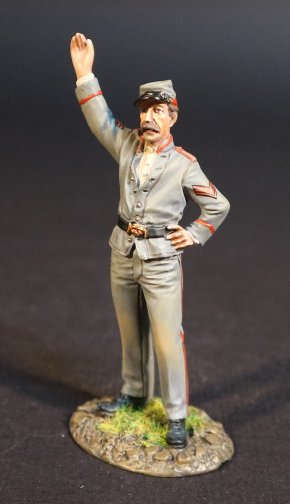
CSART-10
THE AMERICAN CIVIL WAR 1861 - 1865
CONFEDERATE ARTILLERY.
ARTILLERY CREW .
(1 pcs)
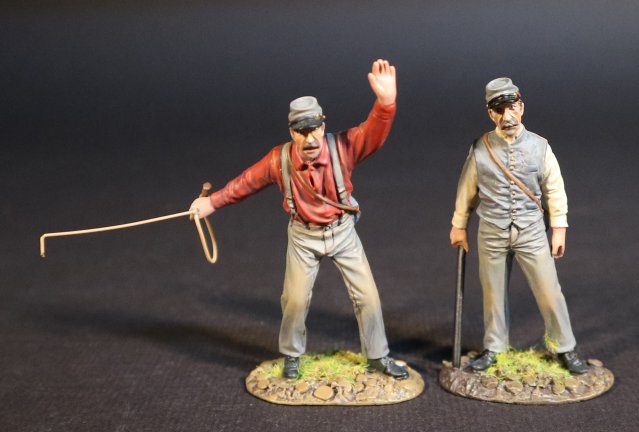
CSART-11
THE AMERICAN CIVIL WAR 1861 - 1865
CONFEDERATE ARTILLERY.
ARTILLERY CREW
(2 pcs)
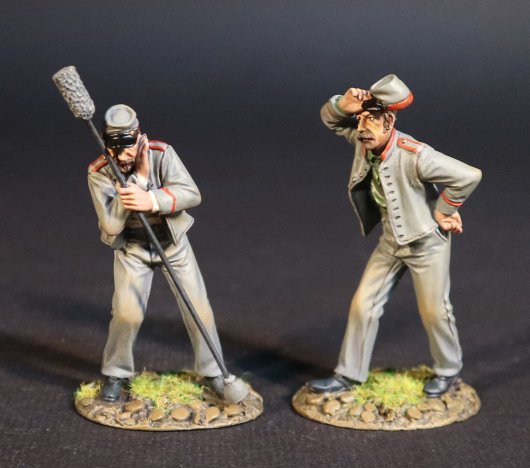
CSART-12
THE AMERICAN CIVIL WAR 1861 - 1865
CONFEDERATE ARTILLERY.
ARTILLERY CREW .
(2 pcs)
THE FIRST BATTLE OF MANASSAS, 1861.
THE ARMY OF THE SHENANDOAH,
1[SUP]st[/SUP] ROCKBRIDGE ARTILLERY
The Seventy men of the 1[SUP]st[/SUP] Rockbridge Artillery were organized in April 1861 by Virginia Military Institute professor John McCausland. William N. Pendleton took command of the battery in late April after McCausland was transferred to command another unit.
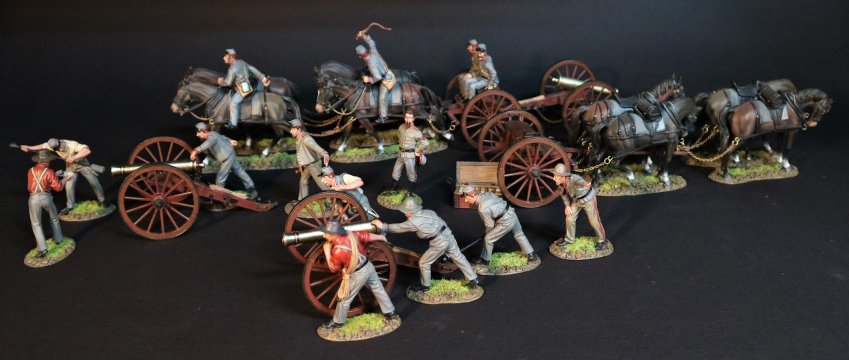
The battery was initially equipped with two 6 pounders from VMI and two guns from Richmond.
Pendleton named the first four guns “Mathew”, “Mark”, “Luke” and “John”, after the Apostles.
The M1841 6-pounder field gun was a bronze smoothbore muzzle-loading cannon that was adopted by the United States Army in 1841 and used from the Mexican-American War to the American Civil War.
It fired a 6.1lb round shot up to a distance of 1,523yds at 5 degree elevation. It could also fire canister shot and spherical case shot.
The cannon was used during the early years of the American Civil War, but it was soon outclassed by newer field guns such as the 12 pounder Napoleon.
In the Union Army, the 6-pounders were replaced as soon as more modern weapons became available and none were manufactured after 1862. However the Confederate States Army continued to use the cannon for a longer period because the lesser industrial capacity of the South could not produce newer guns as fast as the North.
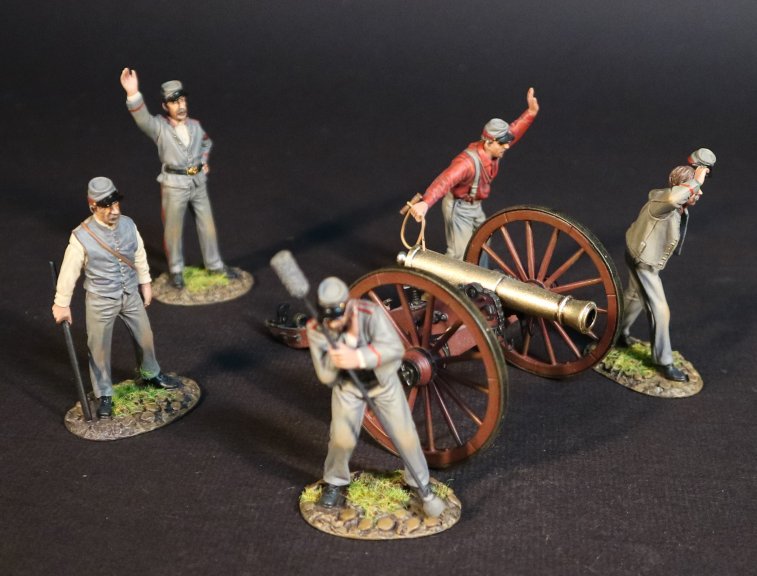
On 18[SUP]th[/SUP] July the battery moved east with the Stonewall Brigade to link up with Confederate general P.G.T. Beauregard’s troops at Manassas Junction. On 21[SUP]st[/SUP] July during the First Battle of Manassas, Pendleton’s Battery was among the Confederate batteries defending the key position of the battle, Henry House Hill. The Battery was visited by Confederate president Jefferson Davis, who had gone to Manassas to watch the battle, during the Union retreat. In the aftermath of the battle, the battery received captured Union cannon.
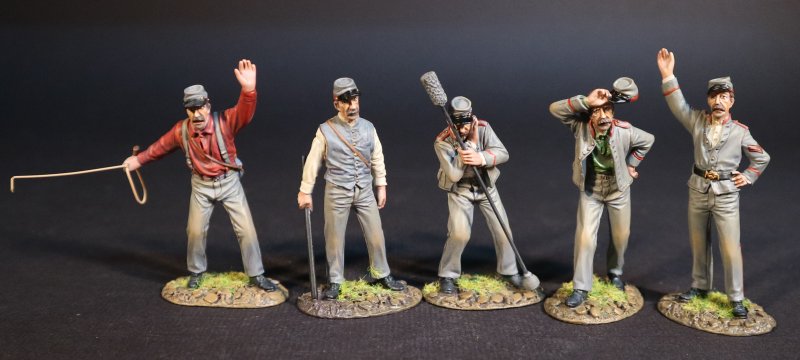
ROCKART-10
THE AMERICAN CIVIL WAR 1861 - 1865
THE FIRST BATTLE OF MANASSAS, 1861.
THE ARMY OF THE SHENANDOAH,
1[SUP]st[/SUP] ROCKBRIDGE ARTILLERY
“LUKE” ARTILLERY CREW.
(5 pcs)
THE FIRST BATTLE OF MANASSAS, 1861,
THE ARMY OF THE SHENANDOAH
THE FIRST BRIGADE
THE 4[SUP]th[/SUP] VIRGINIA INFANTRY.
The 1[SUP]st[/SUP] Brigade of the Army of the Shenandoah, commanded by Brigadier-General Thomas J. Jackson, earned their legendary nickname at First manassas on 21[SUP]st[/SUP] July 1861. Arriving on the battlefield in time to stem the Federal tide sweeping back the confederate left flank, they gained immortality when General Barnard E. Bee, declared: “Look at Jackson’s Brigade! It stands there like a stone wall!”

It was shortly before noon when Jackson arrived at the summit of Henry Hill with his 2,000 Virginians. He rapidly grasped the situation and organized his men into a superb defensive position, which the Northern regiments were unable to break down, and in the end were to wear themselves out in their repeated attempts.
Jackson had situated his men at the edge of the pine woods on Henry Hill, and had ordered them to kneel and lie down to avaid enemy fire.
The 4[SUP]th[/SUP] Virginia served with the Army of Northern Virginia until the end of the war. It was organized along with the 2[SUP]nd[/SUP], 5[SUP]th[/SUP], 27[SUP]th[/SUP] and 33[SUP]rd[/SUP] Virginia Regiments to make up the famous Stonewall Brigade.
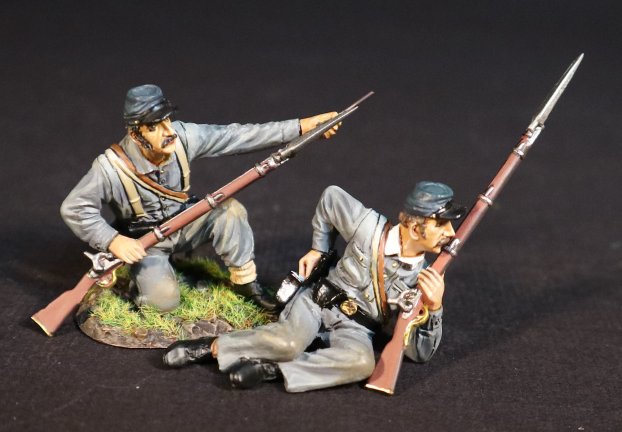
CS4V-14A
THE AMERICAN CIVIL WAR 1861 - 1865
THE FIRST BATTLE OF MANASSAS, 1861
THE ARMY OF THE SHENANDOAH, FIRST BRIGADE,
4[SUP]th[/SUP] VIRGINIA REGIMENT,
2 INFANTRY.
(2 pcs)
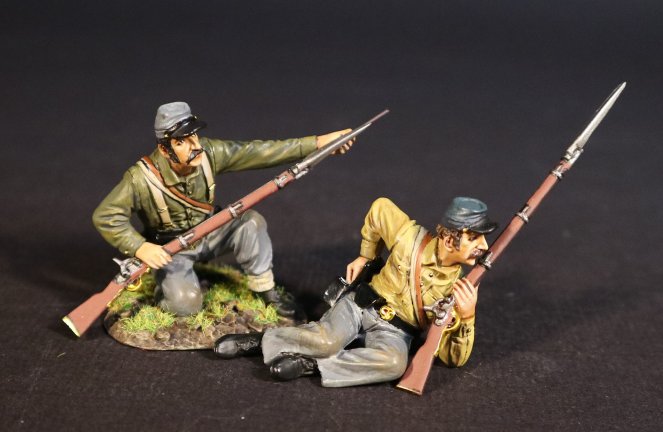
CS4V-14B
THE AMERICAN CIVIL WAR 1861 - 1865
THE FIRST BATTLE OF MANASSAS, 1861
THE ARMY OF THE SHENANDOAH, FIRST BRIGADE,
4[SUP]th[/SUP] VIRGINIA REGIMENT,
2 INFANTRY.
(2 pcs)
** PLEASE CONTACT YOUR LOCAL DEALER FOR FURTHER INFORMATION **
AMERICAN CIVIL WAR
ARTILLERY
A typical “field piece” had an authorized crew of 12 enlisted men constituting a “gun section” led by a sergeant and assisted by one (and sometimes two) corporal. Each section consisted of one “gun,” its “limber” (with one ammunition chest also serving as a seat) and (nominally) six horses (but often only four) to pull it, and a “caisson” (with two ammunition chests/ seats, a spare wheel, tools, and crew baggage) with its own limber pulled by another six horses, and two “spare” horses (when available) tethered to the rear of the caisson. Each “vehicle” was known as a “half section.” Two sections under the command of a second lieutenant constituted a platoon.
While the platoon commander and the two section sergeants (there were no “platoon sergeants” at that time) rode their own assigned horses, six artillerymen rode the three left-side horses in each half section, while the remaining six privates either rode on the three ammunition chests (two to three per chest/seat) or walked alongside. Three platoons (sometimes only two, especially in Confederate units), plus a small headquarters, under a captain, assisted by a first lieutenant and a first sergeant, constituted a “battery.”

CSART-10
THE AMERICAN CIVIL WAR 1861 - 1865
CONFEDERATE ARTILLERY.
ARTILLERY CREW .
(1 pcs)

CSART-11
THE AMERICAN CIVIL WAR 1861 - 1865
CONFEDERATE ARTILLERY.
ARTILLERY CREW
(2 pcs)

CSART-12
THE AMERICAN CIVIL WAR 1861 - 1865
CONFEDERATE ARTILLERY.
ARTILLERY CREW .
(2 pcs)
THE FIRST BATTLE OF MANASSAS, 1861.
THE ARMY OF THE SHENANDOAH,
1[SUP]st[/SUP] ROCKBRIDGE ARTILLERY
The Seventy men of the 1[SUP]st[/SUP] Rockbridge Artillery were organized in April 1861 by Virginia Military Institute professor John McCausland. William N. Pendleton took command of the battery in late April after McCausland was transferred to command another unit.

The battery was initially equipped with two 6 pounders from VMI and two guns from Richmond.
Pendleton named the first four guns “Mathew”, “Mark”, “Luke” and “John”, after the Apostles.
The M1841 6-pounder field gun was a bronze smoothbore muzzle-loading cannon that was adopted by the United States Army in 1841 and used from the Mexican-American War to the American Civil War.
It fired a 6.1lb round shot up to a distance of 1,523yds at 5 degree elevation. It could also fire canister shot and spherical case shot.
The cannon was used during the early years of the American Civil War, but it was soon outclassed by newer field guns such as the 12 pounder Napoleon.
In the Union Army, the 6-pounders were replaced as soon as more modern weapons became available and none were manufactured after 1862. However the Confederate States Army continued to use the cannon for a longer period because the lesser industrial capacity of the South could not produce newer guns as fast as the North.

On 18[SUP]th[/SUP] July the battery moved east with the Stonewall Brigade to link up with Confederate general P.G.T. Beauregard’s troops at Manassas Junction. On 21[SUP]st[/SUP] July during the First Battle of Manassas, Pendleton’s Battery was among the Confederate batteries defending the key position of the battle, Henry House Hill. The Battery was visited by Confederate president Jefferson Davis, who had gone to Manassas to watch the battle, during the Union retreat. In the aftermath of the battle, the battery received captured Union cannon.

ROCKART-10
THE AMERICAN CIVIL WAR 1861 - 1865
THE FIRST BATTLE OF MANASSAS, 1861.
THE ARMY OF THE SHENANDOAH,
1[SUP]st[/SUP] ROCKBRIDGE ARTILLERY
“LUKE” ARTILLERY CREW.
(5 pcs)
THE FIRST BATTLE OF MANASSAS, 1861,
THE ARMY OF THE SHENANDOAH
THE FIRST BRIGADE
THE 4[SUP]th[/SUP] VIRGINIA INFANTRY.
The 1[SUP]st[/SUP] Brigade of the Army of the Shenandoah, commanded by Brigadier-General Thomas J. Jackson, earned their legendary nickname at First manassas on 21[SUP]st[/SUP] July 1861. Arriving on the battlefield in time to stem the Federal tide sweeping back the confederate left flank, they gained immortality when General Barnard E. Bee, declared: “Look at Jackson’s Brigade! It stands there like a stone wall!”

It was shortly before noon when Jackson arrived at the summit of Henry Hill with his 2,000 Virginians. He rapidly grasped the situation and organized his men into a superb defensive position, which the Northern regiments were unable to break down, and in the end were to wear themselves out in their repeated attempts.
Jackson had situated his men at the edge of the pine woods on Henry Hill, and had ordered them to kneel and lie down to avaid enemy fire.
The 4[SUP]th[/SUP] Virginia served with the Army of Northern Virginia until the end of the war. It was organized along with the 2[SUP]nd[/SUP], 5[SUP]th[/SUP], 27[SUP]th[/SUP] and 33[SUP]rd[/SUP] Virginia Regiments to make up the famous Stonewall Brigade.

CS4V-14A
THE AMERICAN CIVIL WAR 1861 - 1865
THE FIRST BATTLE OF MANASSAS, 1861
THE ARMY OF THE SHENANDOAH, FIRST BRIGADE,
4[SUP]th[/SUP] VIRGINIA REGIMENT,
2 INFANTRY.
(2 pcs)

CS4V-14B
THE AMERICAN CIVIL WAR 1861 - 1865
THE FIRST BATTLE OF MANASSAS, 1861
THE ARMY OF THE SHENANDOAH, FIRST BRIGADE,
4[SUP]th[/SUP] VIRGINIA REGIMENT,
2 INFANTRY.
(2 pcs)
** PLEASE CONTACT YOUR LOCAL DEALER FOR FURTHER INFORMATION **

